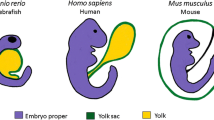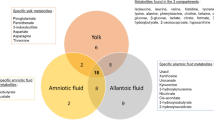Abstract
Histiotrophic nutrition is a process whereby the rodent visceral yolk sac (VYS) internalizes exogenous macromolecules, degrades them, and sends the degradation products to the embryo. Quantification and visualization of histiotrophic nutrition can be accomplished using fluorescent tracer molecules such as fluorescein isothiocyanate-conjugated albumin (FITC-albumin). The methods are simple and can provide complimentary functional and structural information in studies of the effects of embryotoxicants on visceral yolk sac function.
Access this chapter
Tax calculation will be finalised at checkout
Purchases are for personal use only
Similar content being viewed by others
References
Burton GJ (2001) Nutrition of the human fetus during the first trimester—a review. Placenta 22(Suppl A):S70–S77
Burton GJ (2002) Uterine glands provide histiotrophic nutrition for the human fetus during the first trimester of pregnancy. J Clin Endocrinol Metab 87(6):2954–2959
Sant KE, Dolinoy DC, Nahar MS et al (2013) Inhibition of proteolysis in histiotrophic nutrition pathways alters DNA methylation and one-carbon metabolism in the organogenesis-stage rat conceptus. J Nutr Biochem 24(8):1479–1487
Sant KS, Dolinoy DC, Nahar MS, Harris C (2013) Histiotrophic nutrition informs DNA methylation in the rat conceptus. J Nutr Biochem In Press
Sant KE, Dolinoy DC, Jilek JL et al (2016) Mono-2-ethylhexyl phthalate (MEHP) alters histiotrophic nutrition pathways and epigenetic processes in the developing conceptus. J Nutr Biochem 27:211–218
Beckman DA, Pugarelli JE, Koszalka TR et al (1991) Sources of amino acids for protein synthesis during early organogenesis in the rat. 2. Exchange with amino acid and protein pools in embryo and yolk sac. Placenta 12(1):37–46
Beckman DA (1990) Sources of amino acids for protein synthesis during early organogenesis in the rat. I. Relative contributions of free amino acids and of proteins. Placenta 11(2):109–121
Padykula HA, Deren JJ, Wilson TH (1966) Development of structure and function in the mammalian yolk sac: I. Developmental morphology and vitamin B12 uptake of the rat yolk sac. Dev Biol 13(3):311–348
Zohn IE, Sarkar AA (2010) The visceral yolk sac endoderm provides for absorption of nutrients to the embryo during neurulation. Birth Defects Res A Clin Mol Teratol 88(8):593–600
Kozyraki R (2007) Multiligand endocytosis and congenital defects: roles of cubilin, megalin and amnionless. Curr Pharm Des 13(29):3038–3046
Moestrup SK (2001) Megalin- and cubilin-mediated endocytosis of protein-bound vitamins, lipids, and hormones in polarized epithelia. Annu Rev Nutr 21:407–428
Assémat E, Vinot S, Gofflot F et al (2005) Expression and role of cubilin in the internalization of nutrients during the peri-implantation development of the rodent embryo. Biol Reprod 72(5):1079–1086
Ambroso JL (1993) Chloroquine embryotoxicity in the postimplantation rat conceptus in vitro. Teratology 48(3):213–226
Ambroso JL, Harris C (1994) In vitro embryotoxicity of the cysteine proteinase inhibitors benzyloxycarbonyl-phenylalanine-alanine-diazomethane (Z-Phe-Ala-CHN2) and benzyloxycarbony1-phenylalanine-phenylalanine-diazomethane (Z-Phe-Phe-CHN2). Teratology 50(3):214–228
Anderson OS, Sant KE, Dolinoy DC (2012) Nutrition and epigenetics: an interplay of dietary methyl donors, one-carbon metabolism and DNA methylation. J Nutr Biochem 23(8):853–859
Harris C, Jilek JL, Sant KE et al (2015) Amino acid starvation induced by protease inhibition produces differential alterations in redox status and the thiol proteome in organogenesis-stage rat embryos and visceral yolk sacs. J Nutr Biochem 26(12):1589–1598
Jilek JL, Sant KE, Cho KH et al (2015) Ethanol attenuates histiotrophic nutrition pathways and alters the intracellular redox environment and thiol proteome during rat organogenesis. Toxicol Sci 147(2):475–489
Freeman SJ, Beck F, Lloyd JB (1981) The role of the visceral yolk sac in mediating protein utilization by rat embryos cultured in vitro. J Embryol Exp Morphol 66:223–234
Freeman SJ, Lloyd JB (1983) Evidence that protein ingested by the rat visceral yolk sac yields amino acids for synthesis of embryonic protein. J Embryol Exp Morphol 73:307–315
Freeman SJ, Lloyd JB (1982) The effect of teratogenic antiserum on yolk sac function in rat embryos cultured in vitro. J Embryol Exp Morphol 71:63–74
Freeman SJ, Lloyd JB (1983) Inhibition of proteolysis in rat yolk sac as a cause of teratogenesis. Effects of leupeptin in vitro and in vivo. J Embryol Exp Morphol 78:183–193
Freeman SJ, Lloyd JB (1986) Evidence that suramin and aurothiomalate are teratogenic in rat by disturbing yolk sacmediated embryonic protein nutrition. Chem Biol Interact 58:149–160
Hunter ES III, Phillips LS, Goldstein S, Sadler TW (1991) Altered visceral yolk sac function produced by a low molecular weight somatomedin inhibitor. Teratology 43:331–340
Harris C, Dixon M, Hansen JM (2004) Glutathione depletion modulates methanol, formaldehyde and formate toxicity in cultured rat conceptuses. Cell Biol Toxicol 20(3):133–145
Ambroso JL, Harris C (1994) Chloroquine accumulation and alterations in pinocytosis and proteolysis in the rat conceptus in vivo. Biochem Pharmacol 47:679–688
Author information
Authors and Affiliations
Corresponding author
Editor information
Editors and Affiliations
Rights and permissions
Copyright information
© 2019 Springer Science+Business Media, LLC, part of Springer Nature
About this protocol
Cite this protocol
Harris, C. (2019). Assessment of Histiotrophic Nutrition Using Fluorescent Probes. In: Hansen, J., Winn, L. (eds) Developmental Toxicology. Methods in Molecular Biology, vol 1965. Humana, New York, NY. https://doi.org/10.1007/978-1-4939-9182-2_18
Download citation
DOI: https://doi.org/10.1007/978-1-4939-9182-2_18
Published:
Publisher Name: Humana, New York, NY
Print ISBN: 978-1-4939-9181-5
Online ISBN: 978-1-4939-9182-2
eBook Packages: Springer Protocols




